Company Financial Statements Analysis
VerifiedAdded on 2020/04/01
|15
|2434
|193
AI Summary
This assignment presents a set of financial statements for a company. It outlines the company's financial position with details on current and non-current assets, liabilities, and shareholder's equity. The provided figures allow for an analysis of the company's overall financial health and performance.
Contribute Materials
Your contribution can guide someone’s learning journey. Share your
documents today.
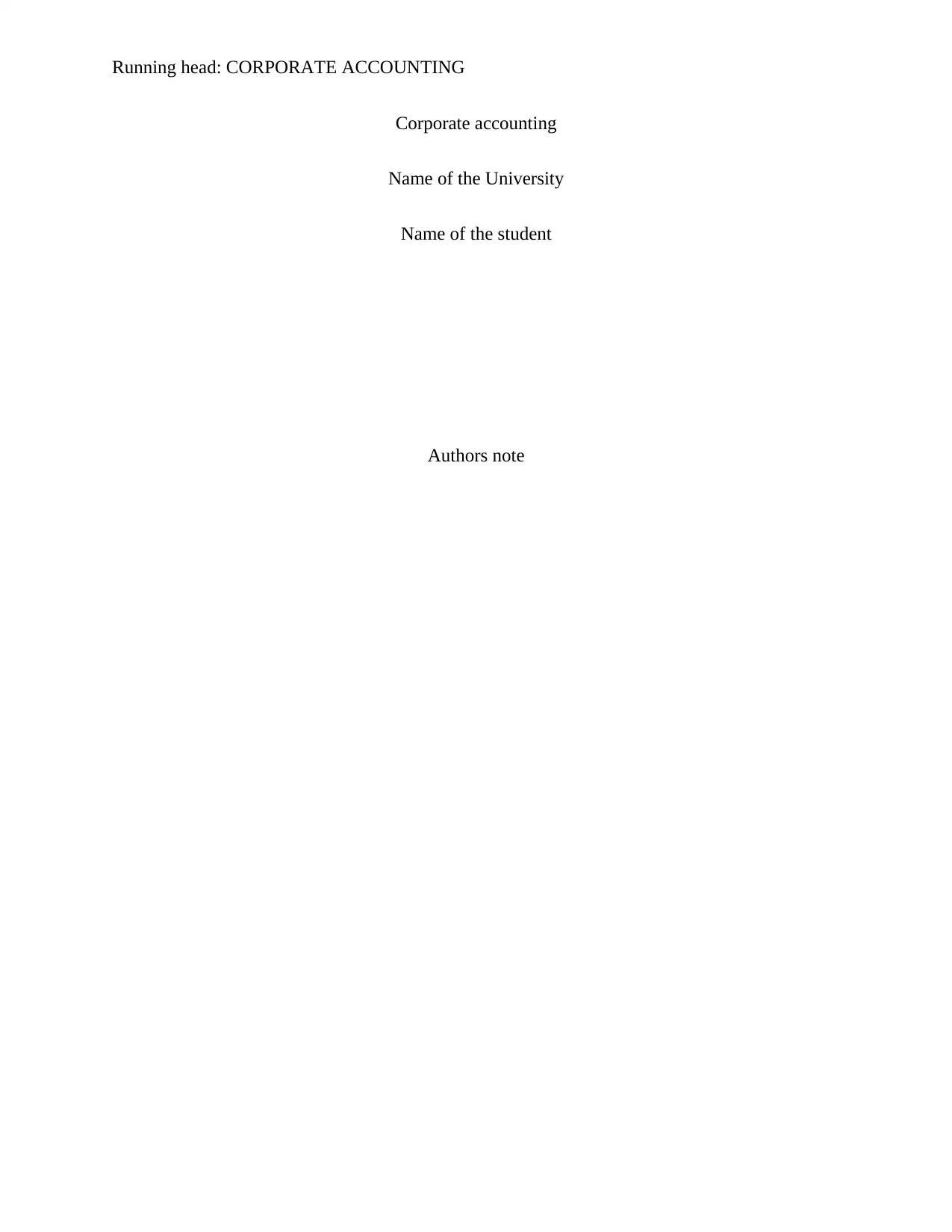
Running head: CORPORATE ACCOUNTING
Corporate accounting
Name of the University
Name of the student
Authors note
Corporate accounting
Name of the University
Name of the student
Authors note
Secure Best Marks with AI Grader
Need help grading? Try our AI Grader for instant feedback on your assignments.
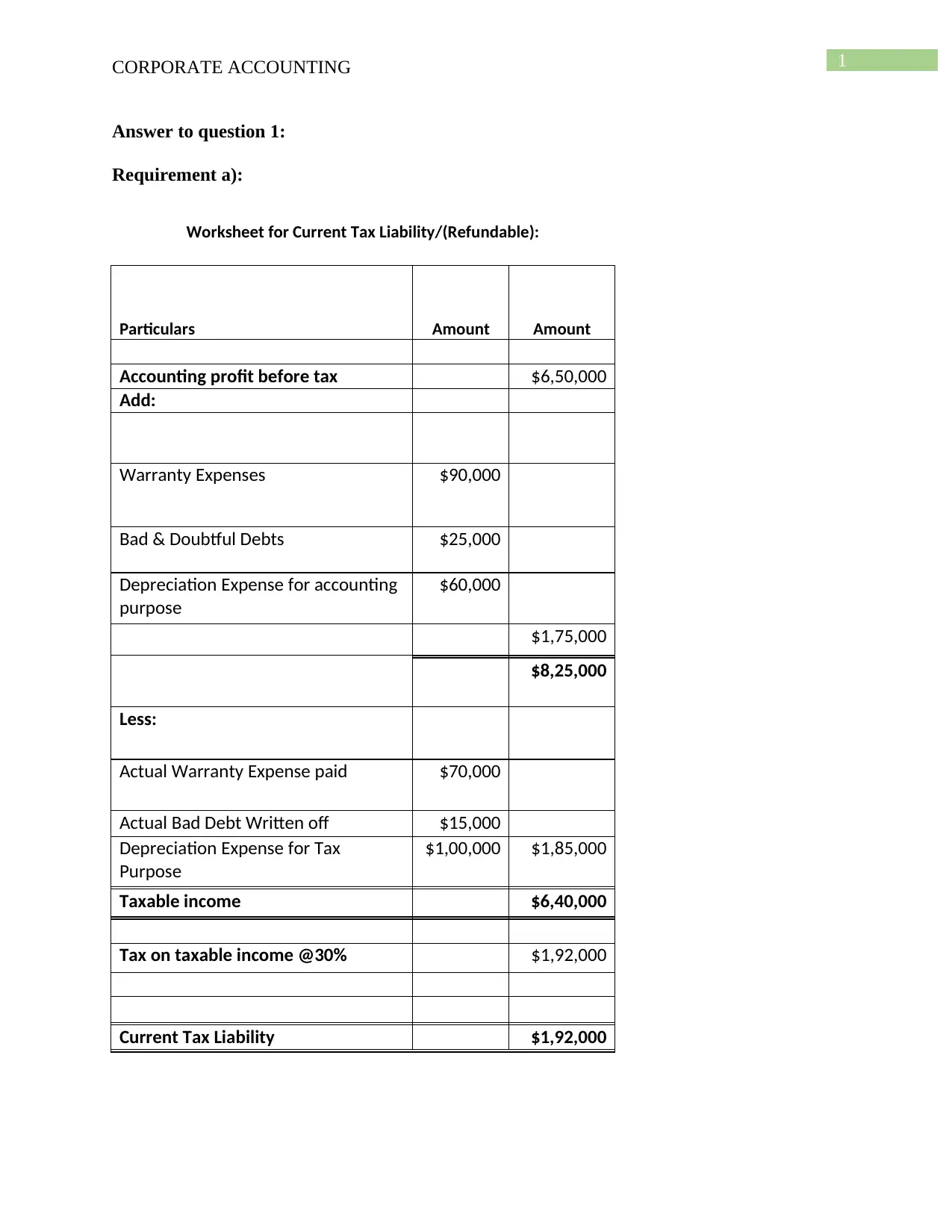
1CORPORATE ACCOUNTING
Answer to question 1:
Requirement a):
Worksheet for Current Tax Liability/(Refundable):
Particulars Amount Amount
Accounting profit before tax $6,50,000
Add:
Warranty Expenses $90,000
Bad & Doubtful Debts $25,000
Depreciation Expense for accounting
purpose
$60,000
$1,75,000
$8,25,000
Less:
Actual Warranty Expense paid $70,000
Actual Bad Debt Written off $15,000
Depreciation Expense for Tax
Purpose
$1,00,000 $1,85,000
Taxable income $6,40,000
Tax on taxable income @30% $1,92,000
Current Tax Liability $1,92,000
Answer to question 1:
Requirement a):
Worksheet for Current Tax Liability/(Refundable):
Particulars Amount Amount
Accounting profit before tax $6,50,000
Add:
Warranty Expenses $90,000
Bad & Doubtful Debts $25,000
Depreciation Expense for accounting
purpose
$60,000
$1,75,000
$8,25,000
Less:
Actual Warranty Expense paid $70,000
Actual Bad Debt Written off $15,000
Depreciation Expense for Tax
Purpose
$1,00,000 $1,85,000
Taxable income $6,40,000
Tax on taxable income @30% $1,92,000
Current Tax Liability $1,92,000
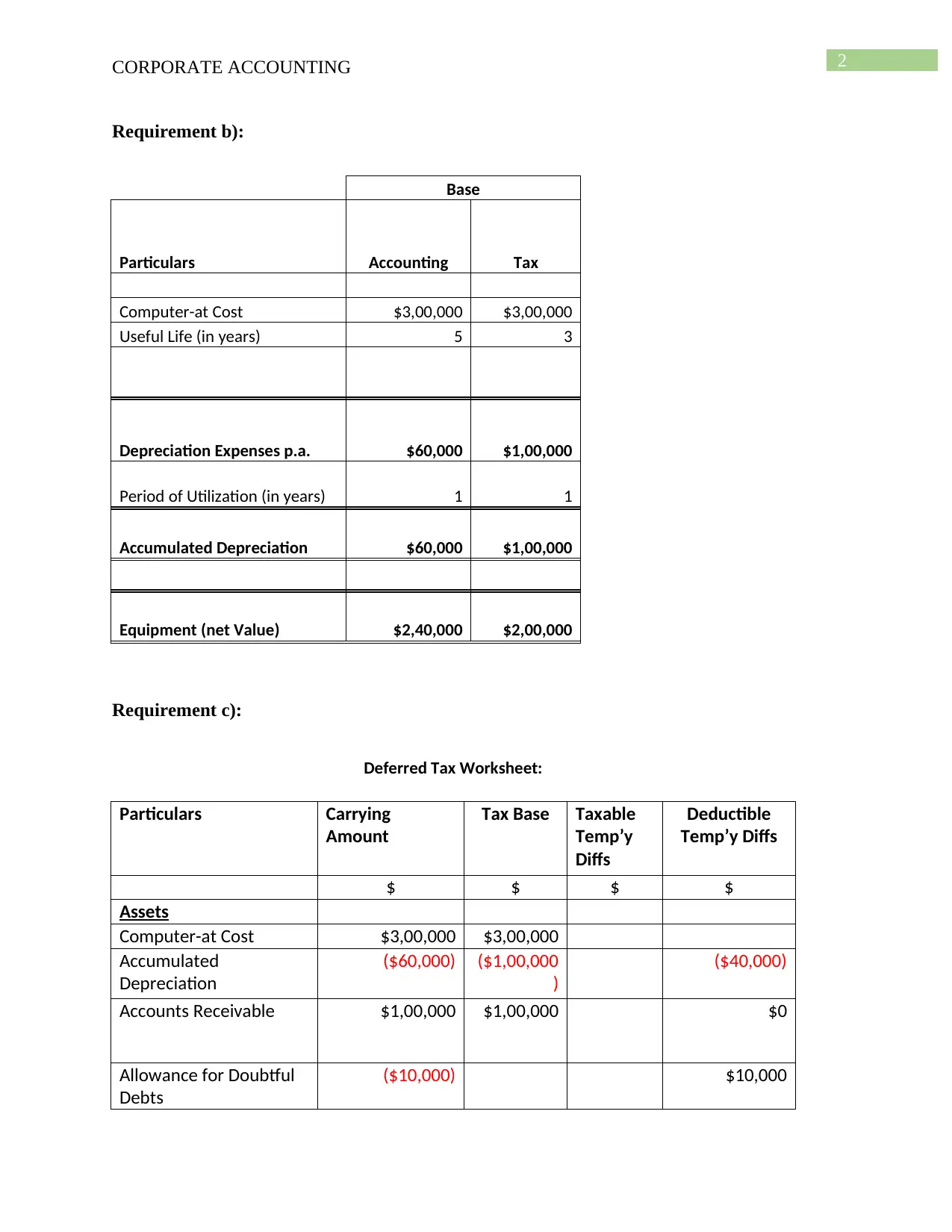
2CORPORATE ACCOUNTING
Requirement b):
Base
Particulars Accounting Tax
Computer-at Cost $3,00,000 $3,00,000
Useful Life (in years) 5 3
Depreciation Expenses p.a. $60,000 $1,00,000
Period of Utilization (in years) 1 1
Accumulated Depreciation $60,000 $1,00,000
Equipment (net Value) $2,40,000 $2,00,000
Requirement c):
Deferred Tax Worksheet:
Particulars Carrying
Amount
Tax Base Taxable
Temp’y
Diffs
Deductible
Temp’y Diffs
$ $ $ $
Assets
Computer-at Cost $3,00,000 $3,00,000
Accumulated
Depreciation
($60,000) ($1,00,000
)
($40,000)
Accounts Receivable $1,00,000 $1,00,000 $0
Allowance for Doubtful
Debts
($10,000) $10,000
Requirement b):
Base
Particulars Accounting Tax
Computer-at Cost $3,00,000 $3,00,000
Useful Life (in years) 5 3
Depreciation Expenses p.a. $60,000 $1,00,000
Period of Utilization (in years) 1 1
Accumulated Depreciation $60,000 $1,00,000
Equipment (net Value) $2,40,000 $2,00,000
Requirement c):
Deferred Tax Worksheet:
Particulars Carrying
Amount
Tax Base Taxable
Temp’y
Diffs
Deductible
Temp’y Diffs
$ $ $ $
Assets
Computer-at Cost $3,00,000 $3,00,000
Accumulated
Depreciation
($60,000) ($1,00,000
)
($40,000)
Accounts Receivable $1,00,000 $1,00,000 $0
Allowance for Doubtful
Debts
($10,000) $10,000
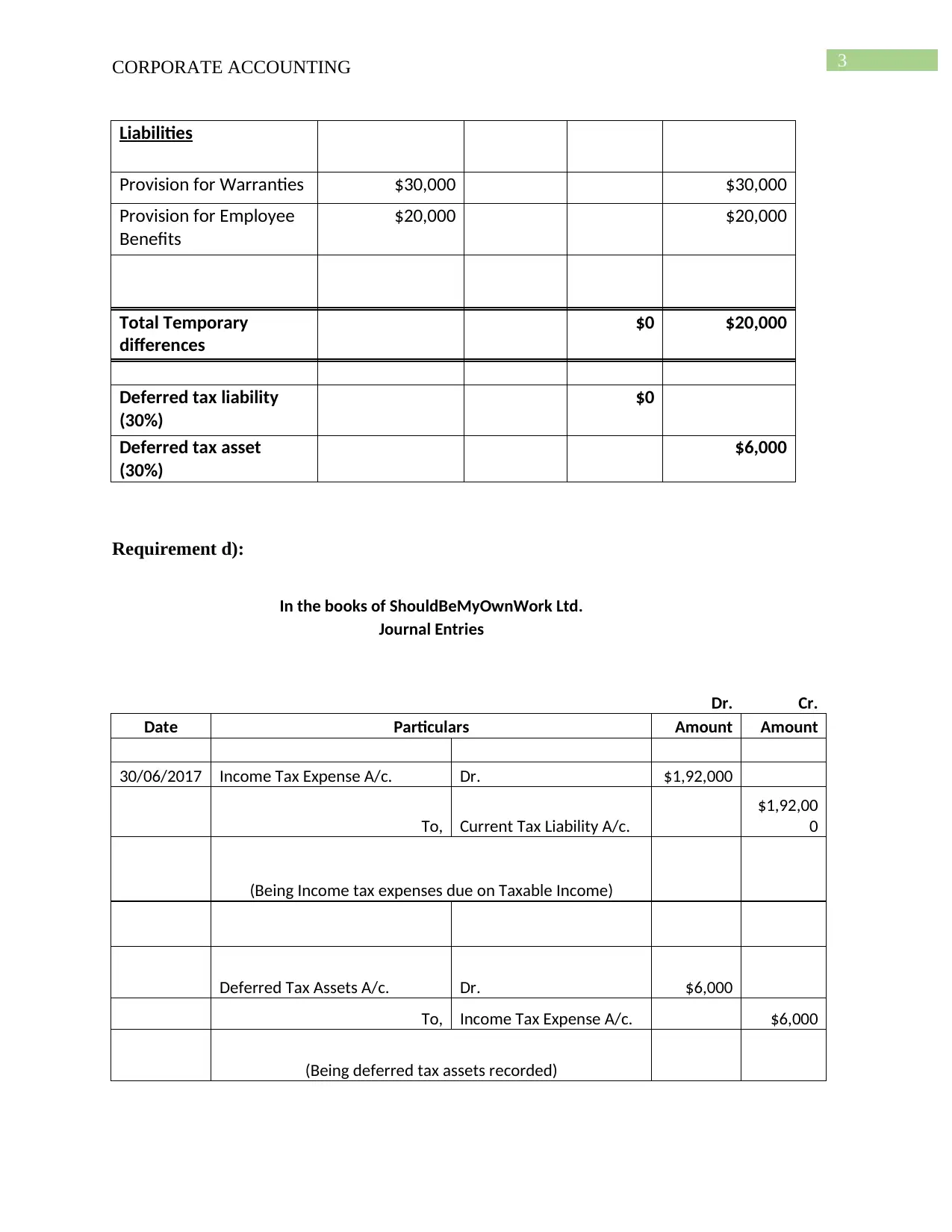
3CORPORATE ACCOUNTING
Liabilities
Provision for Warranties $30,000 $30,000
Provision for Employee
Benefits
$20,000 $20,000
Total Temporary
differences
$0 $20,000
Deferred tax liability
(30%)
$0
Deferred tax asset
(30%)
$6,000
Requirement d):
In the books of ShouldBeMyOwnWork Ltd.
Journal Entries
Dr. Cr.
Date Particulars Amount Amount
30/06/2017 Income Tax Expense A/c. Dr. $1,92,000
To, Current Tax Liability A/c.
$1,92,00
0
(Being Income tax expenses due on Taxable Income)
Deferred Tax Assets A/c. Dr. $6,000
To, Income Tax Expense A/c. $6,000
(Being deferred tax assets recorded)
Liabilities
Provision for Warranties $30,000 $30,000
Provision for Employee
Benefits
$20,000 $20,000
Total Temporary
differences
$0 $20,000
Deferred tax liability
(30%)
$0
Deferred tax asset
(30%)
$6,000
Requirement d):
In the books of ShouldBeMyOwnWork Ltd.
Journal Entries
Dr. Cr.
Date Particulars Amount Amount
30/06/2017 Income Tax Expense A/c. Dr. $1,92,000
To, Current Tax Liability A/c.
$1,92,00
0
(Being Income tax expenses due on Taxable Income)
Deferred Tax Assets A/c. Dr. $6,000
To, Income Tax Expense A/c. $6,000
(Being deferred tax assets recorded)
Secure Best Marks with AI Grader
Need help grading? Try our AI Grader for instant feedback on your assignments.
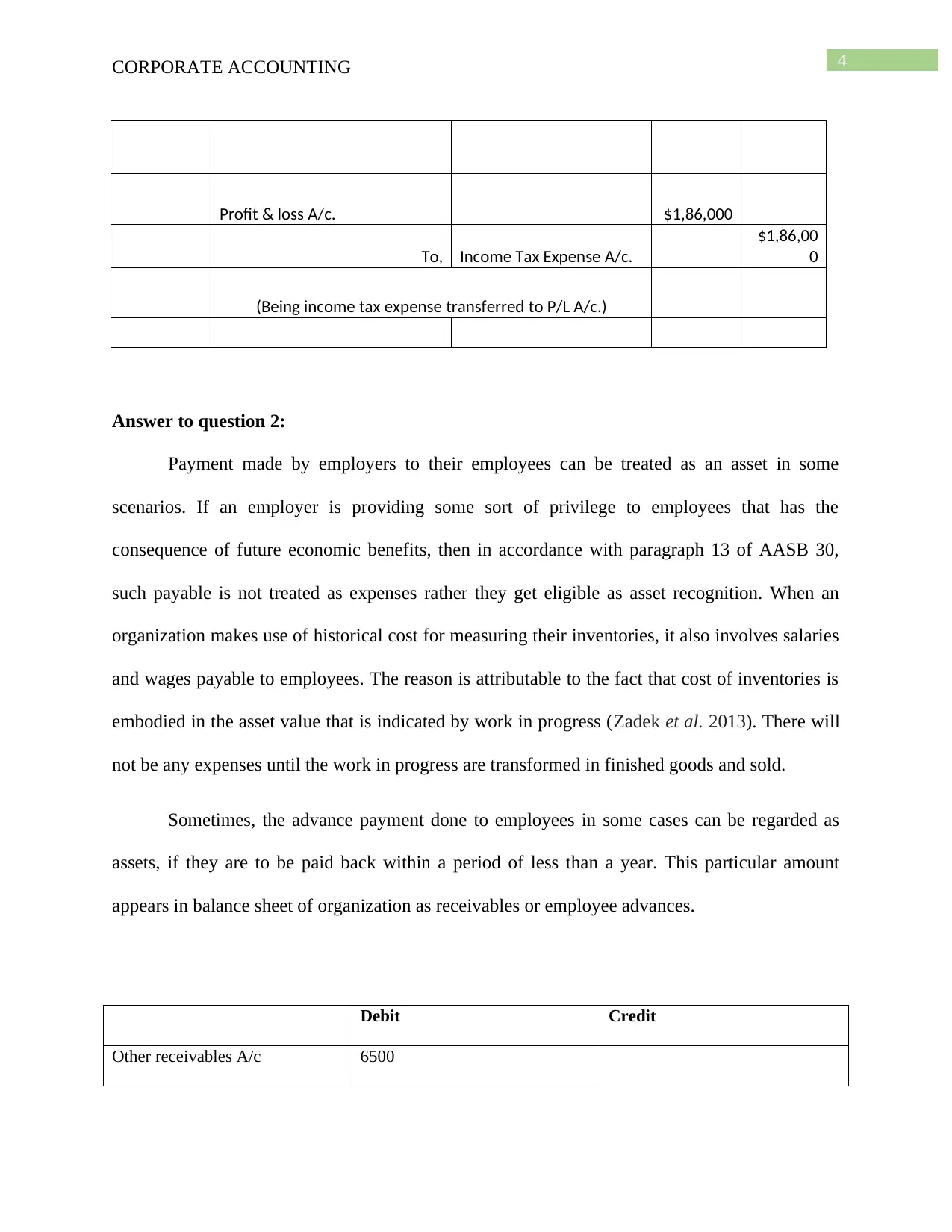
4CORPORATE ACCOUNTING
Profit & loss A/c. $1,86,000
To, Income Tax Expense A/c.
$1,86,00
0
(Being income tax expense transferred to P/L A/c.)
Answer to question 2:
Payment made by employers to their employees can be treated as an asset in some
scenarios. If an employer is providing some sort of privilege to employees that has the
consequence of future economic benefits, then in accordance with paragraph 13 of AASB 30,
such payable is not treated as expenses rather they get eligible as asset recognition. When an
organization makes use of historical cost for measuring their inventories, it also involves salaries
and wages payable to employees. The reason is attributable to the fact that cost of inventories is
embodied in the asset value that is indicated by work in progress (Zadek et al. 2013). There will
not be any expenses until the work in progress are transformed in finished goods and sold.
Sometimes, the advance payment done to employees in some cases can be regarded as
assets, if they are to be paid back within a period of less than a year. This particular amount
appears in balance sheet of organization as receivables or employee advances.
Debit Credit
Other receivables A/c 6500
Profit & loss A/c. $1,86,000
To, Income Tax Expense A/c.
$1,86,00
0
(Being income tax expense transferred to P/L A/c.)
Answer to question 2:
Payment made by employers to their employees can be treated as an asset in some
scenarios. If an employer is providing some sort of privilege to employees that has the
consequence of future economic benefits, then in accordance with paragraph 13 of AASB 30,
such payable is not treated as expenses rather they get eligible as asset recognition. When an
organization makes use of historical cost for measuring their inventories, it also involves salaries
and wages payable to employees. The reason is attributable to the fact that cost of inventories is
embodied in the asset value that is indicated by work in progress (Zadek et al. 2013). There will
not be any expenses until the work in progress are transformed in finished goods and sold.
Sometimes, the advance payment done to employees in some cases can be regarded as
assets, if they are to be paid back within a period of less than a year. This particular amount
appears in balance sheet of organization as receivables or employee advances.
Debit Credit
Other receivables A/c 6500
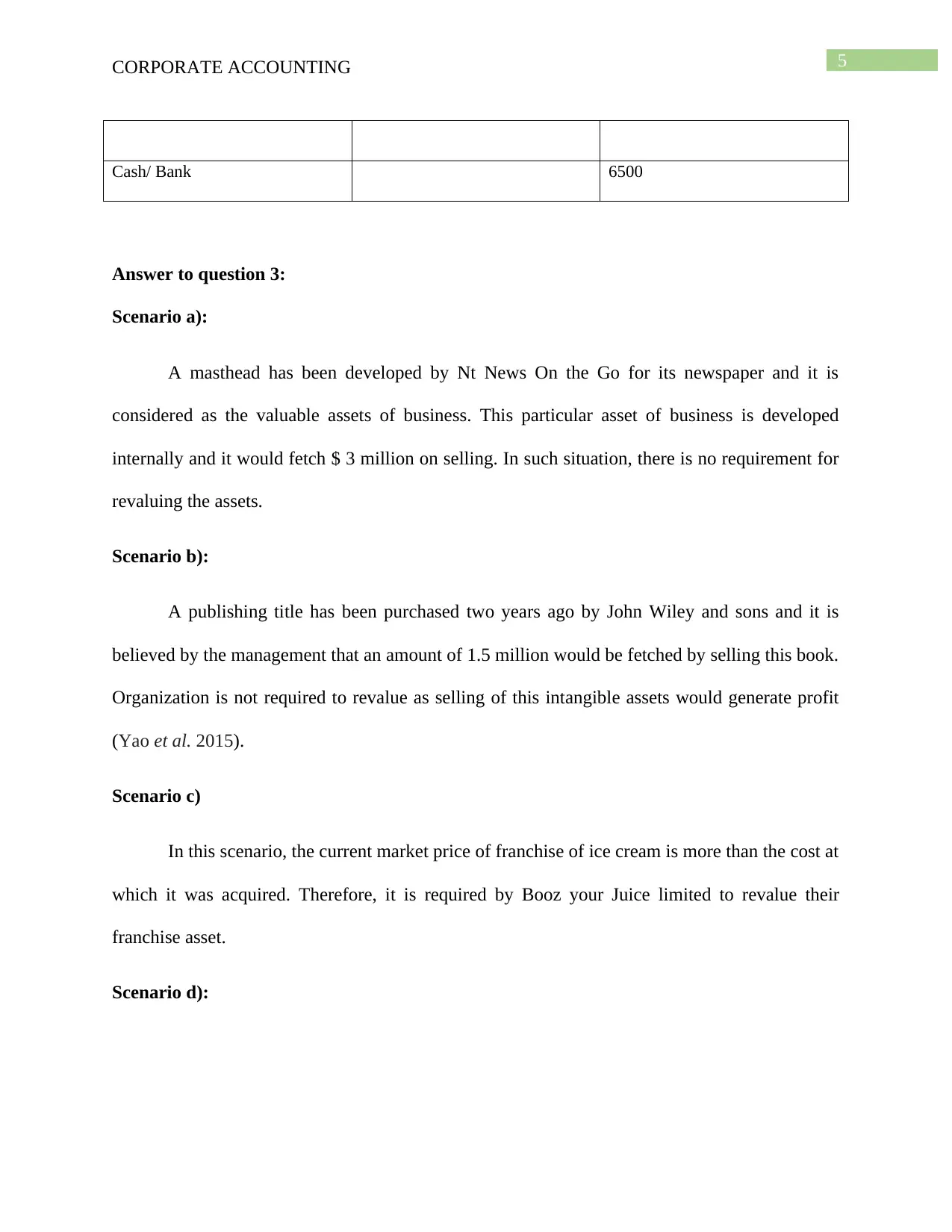
5CORPORATE ACCOUNTING
Cash/ Bank 6500
Answer to question 3:
Scenario a):
A masthead has been developed by Nt News On the Go for its newspaper and it is
considered as the valuable assets of business. This particular asset of business is developed
internally and it would fetch $ 3 million on selling. In such situation, there is no requirement for
revaluing the assets.
Scenario b):
A publishing title has been purchased two years ago by John Wiley and sons and it is
believed by the management that an amount of 1.5 million would be fetched by selling this book.
Organization is not required to revalue as selling of this intangible assets would generate profit
(Yao et al. 2015).
Scenario c)
In this scenario, the current market price of franchise of ice cream is more than the cost at
which it was acquired. Therefore, it is required by Booz your Juice limited to revalue their
franchise asset.
Scenario d):
Cash/ Bank 6500
Answer to question 3:
Scenario a):
A masthead has been developed by Nt News On the Go for its newspaper and it is
considered as the valuable assets of business. This particular asset of business is developed
internally and it would fetch $ 3 million on selling. In such situation, there is no requirement for
revaluing the assets.
Scenario b):
A publishing title has been purchased two years ago by John Wiley and sons and it is
believed by the management that an amount of 1.5 million would be fetched by selling this book.
Organization is not required to revalue as selling of this intangible assets would generate profit
(Yao et al. 2015).
Scenario c)
In this scenario, the current market price of franchise of ice cream is more than the cost at
which it was acquired. Therefore, it is required by Booz your Juice limited to revalue their
franchise asset.
Scenario d):
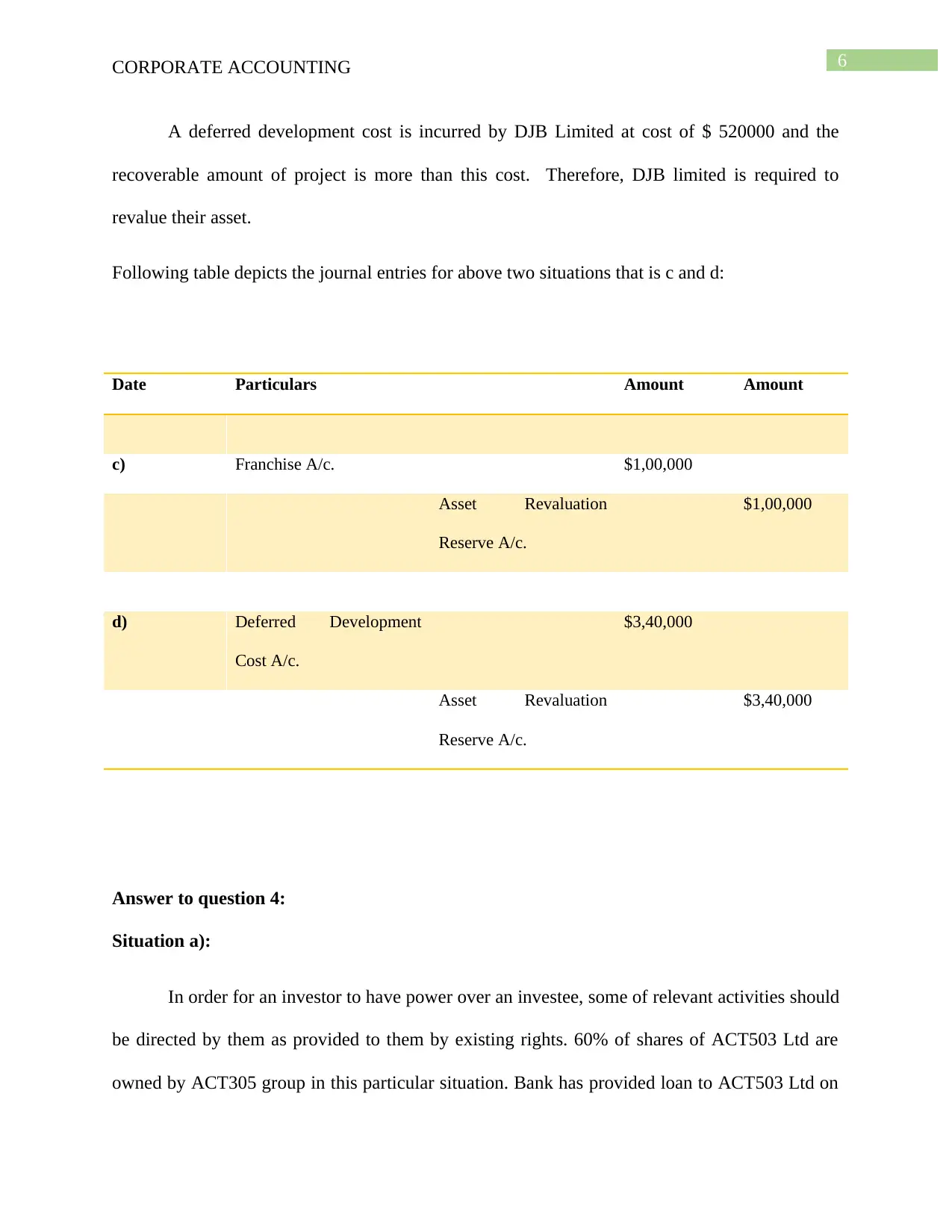
6CORPORATE ACCOUNTING
A deferred development cost is incurred by DJB Limited at cost of $ 520000 and the
recoverable amount of project is more than this cost. Therefore, DJB limited is required to
revalue their asset.
Following table depicts the journal entries for above two situations that is c and d:
Date Particulars Amount Amount
c) Franchise A/c. $1,00,000
Asset Revaluation
Reserve A/c.
$1,00,000
d) Deferred Development
Cost A/c.
$3,40,000
Asset Revaluation
Reserve A/c.
$3,40,000
Answer to question 4:
Situation a):
In order for an investor to have power over an investee, some of relevant activities should
be directed by them as provided to them by existing rights. 60% of shares of ACT503 Ltd are
owned by ACT305 group in this particular situation. Bank has provided loan to ACT503 Ltd on
A deferred development cost is incurred by DJB Limited at cost of $ 520000 and the
recoverable amount of project is more than this cost. Therefore, DJB limited is required to
revalue their asset.
Following table depicts the journal entries for above two situations that is c and d:
Date Particulars Amount Amount
c) Franchise A/c. $1,00,000
Asset Revaluation
Reserve A/c.
$1,00,000
d) Deferred Development
Cost A/c.
$3,40,000
Asset Revaluation
Reserve A/c.
$3,40,000
Answer to question 4:
Situation a):
In order for an investor to have power over an investee, some of relevant activities should
be directed by them as provided to them by existing rights. 60% of shares of ACT503 Ltd are
owned by ACT305 group in this particular situation. Bank has provided loan to ACT503 Ltd on
Paraphrase This Document
Need a fresh take? Get an instant paraphrase of this document with our AI Paraphraser
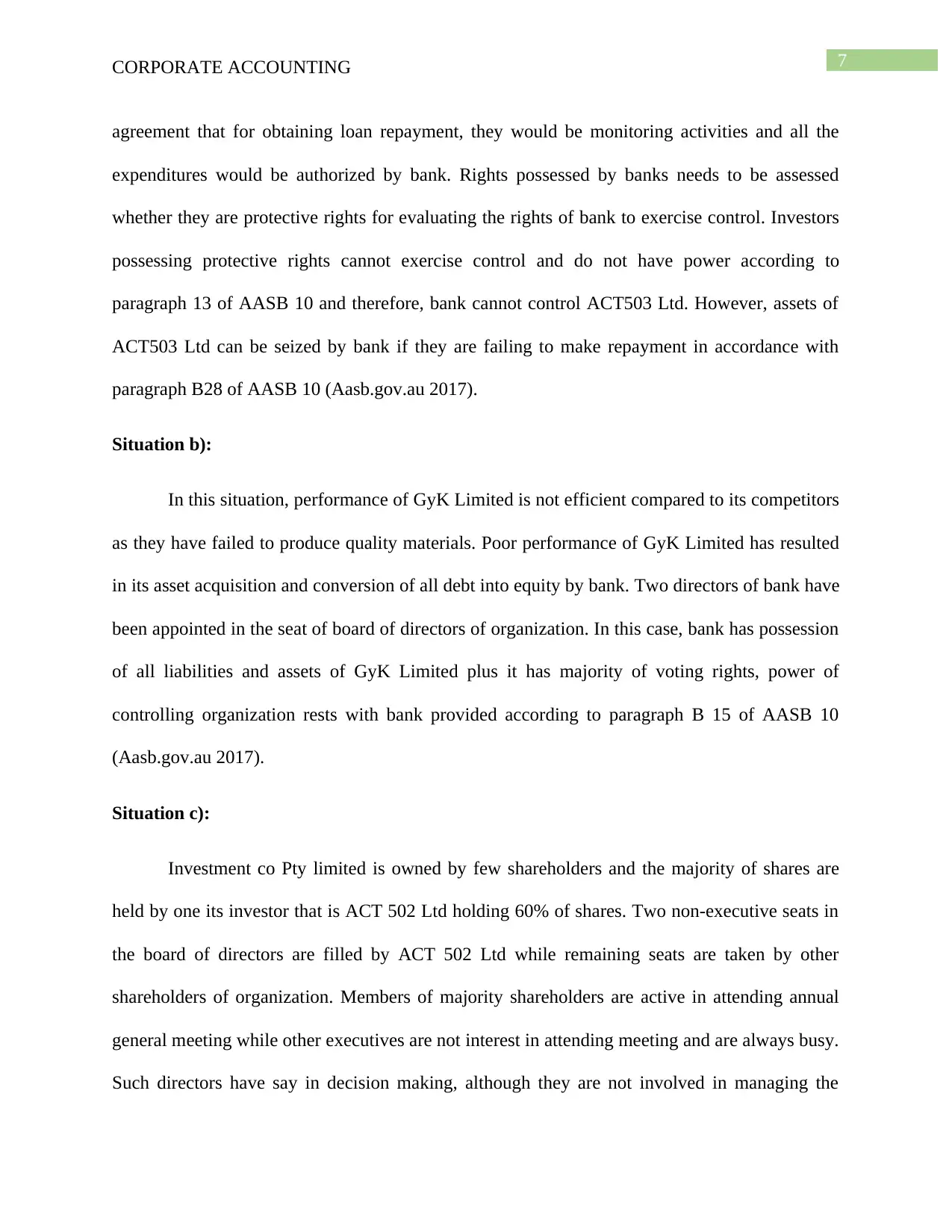
7CORPORATE ACCOUNTING
agreement that for obtaining loan repayment, they would be monitoring activities and all the
expenditures would be authorized by bank. Rights possessed by banks needs to be assessed
whether they are protective rights for evaluating the rights of bank to exercise control. Investors
possessing protective rights cannot exercise control and do not have power according to
paragraph 13 of AASB 10 and therefore, bank cannot control ACT503 Ltd. However, assets of
ACT503 Ltd can be seized by bank if they are failing to make repayment in accordance with
paragraph B28 of AASB 10 (Aasb.gov.au 2017).
Situation b):
In this situation, performance of GyK Limited is not efficient compared to its competitors
as they have failed to produce quality materials. Poor performance of GyK Limited has resulted
in its asset acquisition and conversion of all debt into equity by bank. Two directors of bank have
been appointed in the seat of board of directors of organization. In this case, bank has possession
of all liabilities and assets of GyK Limited plus it has majority of voting rights, power of
controlling organization rests with bank provided according to paragraph B 15 of AASB 10
(Aasb.gov.au 2017).
Situation c):
Investment co Pty limited is owned by few shareholders and the majority of shares are
held by one its investor that is ACT 502 Ltd holding 60% of shares. Two non-executive seats in
the board of directors are filled by ACT 502 Ltd while remaining seats are taken by other
shareholders of organization. Members of majority shareholders are active in attending annual
general meeting while other executives are not interest in attending meeting and are always busy.
Such directors have say in decision making, although they are not involved in managing the
agreement that for obtaining loan repayment, they would be monitoring activities and all the
expenditures would be authorized by bank. Rights possessed by banks needs to be assessed
whether they are protective rights for evaluating the rights of bank to exercise control. Investors
possessing protective rights cannot exercise control and do not have power according to
paragraph 13 of AASB 10 and therefore, bank cannot control ACT503 Ltd. However, assets of
ACT503 Ltd can be seized by bank if they are failing to make repayment in accordance with
paragraph B28 of AASB 10 (Aasb.gov.au 2017).
Situation b):
In this situation, performance of GyK Limited is not efficient compared to its competitors
as they have failed to produce quality materials. Poor performance of GyK Limited has resulted
in its asset acquisition and conversion of all debt into equity by bank. Two directors of bank have
been appointed in the seat of board of directors of organization. In this case, bank has possession
of all liabilities and assets of GyK Limited plus it has majority of voting rights, power of
controlling organization rests with bank provided according to paragraph B 15 of AASB 10
(Aasb.gov.au 2017).
Situation c):
Investment co Pty limited is owned by few shareholders and the majority of shares are
held by one its investor that is ACT 502 Ltd holding 60% of shares. Two non-executive seats in
the board of directors are filled by ACT 502 Ltd while remaining seats are taken by other
shareholders of organization. Members of majority shareholders are active in attending annual
general meeting while other executives are not interest in attending meeting and are always busy.
Such directors have say in decision making, although they are not involved in managing the
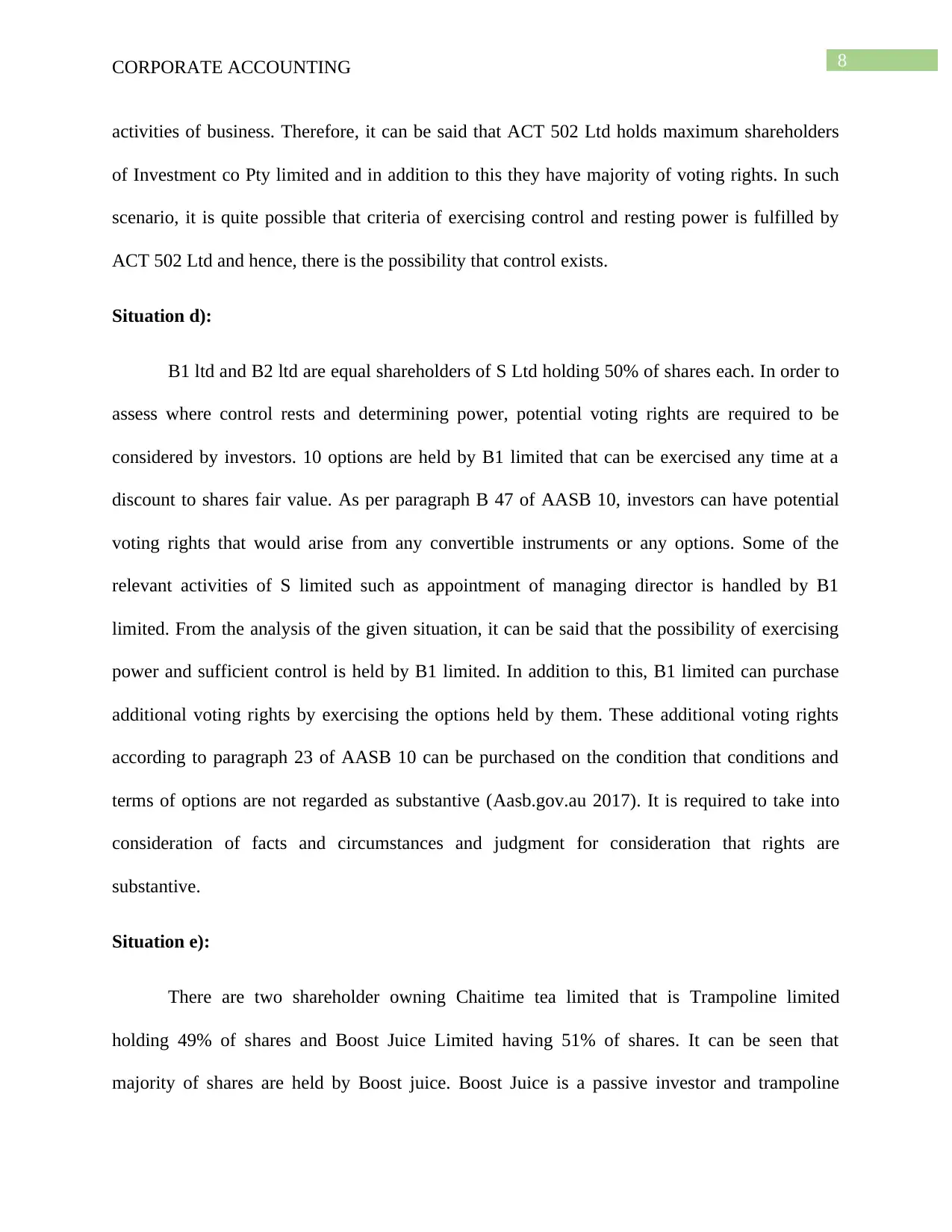
8CORPORATE ACCOUNTING
activities of business. Therefore, it can be said that ACT 502 Ltd holds maximum shareholders
of Investment co Pty limited and in addition to this they have majority of voting rights. In such
scenario, it is quite possible that criteria of exercising control and resting power is fulfilled by
ACT 502 Ltd and hence, there is the possibility that control exists.
Situation d):
B1 ltd and B2 ltd are equal shareholders of S Ltd holding 50% of shares each. In order to
assess where control rests and determining power, potential voting rights are required to be
considered by investors. 10 options are held by B1 limited that can be exercised any time at a
discount to shares fair value. As per paragraph B 47 of AASB 10, investors can have potential
voting rights that would arise from any convertible instruments or any options. Some of the
relevant activities of S limited such as appointment of managing director is handled by B1
limited. From the analysis of the given situation, it can be said that the possibility of exercising
power and sufficient control is held by B1 limited. In addition to this, B1 limited can purchase
additional voting rights by exercising the options held by them. These additional voting rights
according to paragraph 23 of AASB 10 can be purchased on the condition that conditions and
terms of options are not regarded as substantive (Aasb.gov.au 2017). It is required to take into
consideration of facts and circumstances and judgment for consideration that rights are
substantive.
Situation e):
There are two shareholder owning Chaitime tea limited that is Trampoline limited
holding 49% of shares and Boost Juice Limited having 51% of shares. It can be seen that
majority of shares are held by Boost juice. Boost Juice is a passive investor and trampoline
activities of business. Therefore, it can be said that ACT 502 Ltd holds maximum shareholders
of Investment co Pty limited and in addition to this they have majority of voting rights. In such
scenario, it is quite possible that criteria of exercising control and resting power is fulfilled by
ACT 502 Ltd and hence, there is the possibility that control exists.
Situation d):
B1 ltd and B2 ltd are equal shareholders of S Ltd holding 50% of shares each. In order to
assess where control rests and determining power, potential voting rights are required to be
considered by investors. 10 options are held by B1 limited that can be exercised any time at a
discount to shares fair value. As per paragraph B 47 of AASB 10, investors can have potential
voting rights that would arise from any convertible instruments or any options. Some of the
relevant activities of S limited such as appointment of managing director is handled by B1
limited. From the analysis of the given situation, it can be said that the possibility of exercising
power and sufficient control is held by B1 limited. In addition to this, B1 limited can purchase
additional voting rights by exercising the options held by them. These additional voting rights
according to paragraph 23 of AASB 10 can be purchased on the condition that conditions and
terms of options are not regarded as substantive (Aasb.gov.au 2017). It is required to take into
consideration of facts and circumstances and judgment for consideration that rights are
substantive.
Situation e):
There are two shareholder owning Chaitime tea limited that is Trampoline limited
holding 49% of shares and Boost Juice Limited having 51% of shares. It can be seen that
majority of shares are held by Boost juice. Boost Juice is a passive investor and trampoline
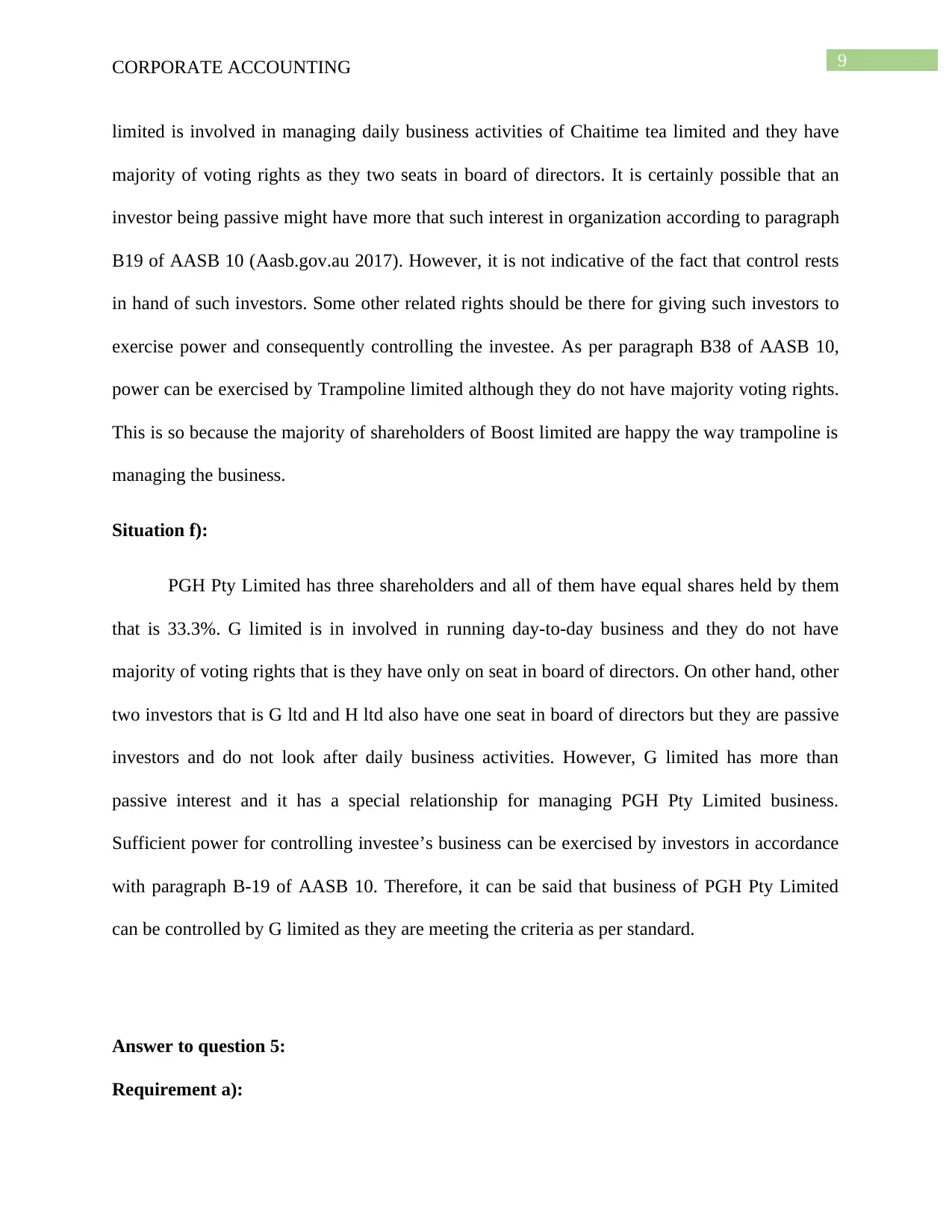
9CORPORATE ACCOUNTING
limited is involved in managing daily business activities of Chaitime tea limited and they have
majority of voting rights as they two seats in board of directors. It is certainly possible that an
investor being passive might have more that such interest in organization according to paragraph
B19 of AASB 10 (Aasb.gov.au 2017). However, it is not indicative of the fact that control rests
in hand of such investors. Some other related rights should be there for giving such investors to
exercise power and consequently controlling the investee. As per paragraph B38 of AASB 10,
power can be exercised by Trampoline limited although they do not have majority voting rights.
This is so because the majority of shareholders of Boost limited are happy the way trampoline is
managing the business.
Situation f):
PGH Pty Limited has three shareholders and all of them have equal shares held by them
that is 33.3%. G limited is in involved in running day-to-day business and they do not have
majority of voting rights that is they have only on seat in board of directors. On other hand, other
two investors that is G ltd and H ltd also have one seat in board of directors but they are passive
investors and do not look after daily business activities. However, G limited has more than
passive interest and it has a special relationship for managing PGH Pty Limited business.
Sufficient power for controlling investee’s business can be exercised by investors in accordance
with paragraph B-19 of AASB 10. Therefore, it can be said that business of PGH Pty Limited
can be controlled by G limited as they are meeting the criteria as per standard.
Answer to question 5:
Requirement a):
limited is involved in managing daily business activities of Chaitime tea limited and they have
majority of voting rights as they two seats in board of directors. It is certainly possible that an
investor being passive might have more that such interest in organization according to paragraph
B19 of AASB 10 (Aasb.gov.au 2017). However, it is not indicative of the fact that control rests
in hand of such investors. Some other related rights should be there for giving such investors to
exercise power and consequently controlling the investee. As per paragraph B38 of AASB 10,
power can be exercised by Trampoline limited although they do not have majority voting rights.
This is so because the majority of shareholders of Boost limited are happy the way trampoline is
managing the business.
Situation f):
PGH Pty Limited has three shareholders and all of them have equal shares held by them
that is 33.3%. G limited is in involved in running day-to-day business and they do not have
majority of voting rights that is they have only on seat in board of directors. On other hand, other
two investors that is G ltd and H ltd also have one seat in board of directors but they are passive
investors and do not look after daily business activities. However, G limited has more than
passive interest and it has a special relationship for managing PGH Pty Limited business.
Sufficient power for controlling investee’s business can be exercised by investors in accordance
with paragraph B-19 of AASB 10. Therefore, it can be said that business of PGH Pty Limited
can be controlled by G limited as they are meeting the criteria as per standard.
Answer to question 5:
Requirement a):
Secure Best Marks with AI Grader
Need help grading? Try our AI Grader for instant feedback on your assignments.

10CORPORATE ACCOUNTING
Acquisition Analysis:
Particulars
Carrying
Amount Fair Value
Net Fair
Value
Share Capital $0 $5,00,000
$5,00,00
0
Retained Earnings $0 $2,00,000
$2,00,00
0
Property, Plant & Equipment $4,30,000 $5,30,000
$1,00,00
0
Net Fair Value of Identifiable
Assets & Liabilities A
$8,00,00
0
Purchase Consideration B
$9,00,00
0
Goodwill C=B-A
$1,00,00
0
Requirement b):
In the books of ChallengeMe Pty. Ltd.
Journal Entries
Dr. Cr.
Date Particulars Amount Amount
1 Business Combination Valuation Entries:
1.a
Accumulated Depreciation
A/c. $2,70,000
Property, Plant & Equipment A/c. $1,00,000
Deferred Tax Liability A/c. $51,000
Business Combination Valuation
Reserve A/c. $1,19,000
Acquisition Analysis:
Particulars
Carrying
Amount Fair Value
Net Fair
Value
Share Capital $0 $5,00,000
$5,00,00
0
Retained Earnings $0 $2,00,000
$2,00,00
0
Property, Plant & Equipment $4,30,000 $5,30,000
$1,00,00
0
Net Fair Value of Identifiable
Assets & Liabilities A
$8,00,00
0
Purchase Consideration B
$9,00,00
0
Goodwill C=B-A
$1,00,00
0
Requirement b):
In the books of ChallengeMe Pty. Ltd.
Journal Entries
Dr. Cr.
Date Particulars Amount Amount
1 Business Combination Valuation Entries:
1.a
Accumulated Depreciation
A/c. $2,70,000
Property, Plant & Equipment A/c. $1,00,000
Deferred Tax Liability A/c. $51,000
Business Combination Valuation
Reserve A/c. $1,19,000
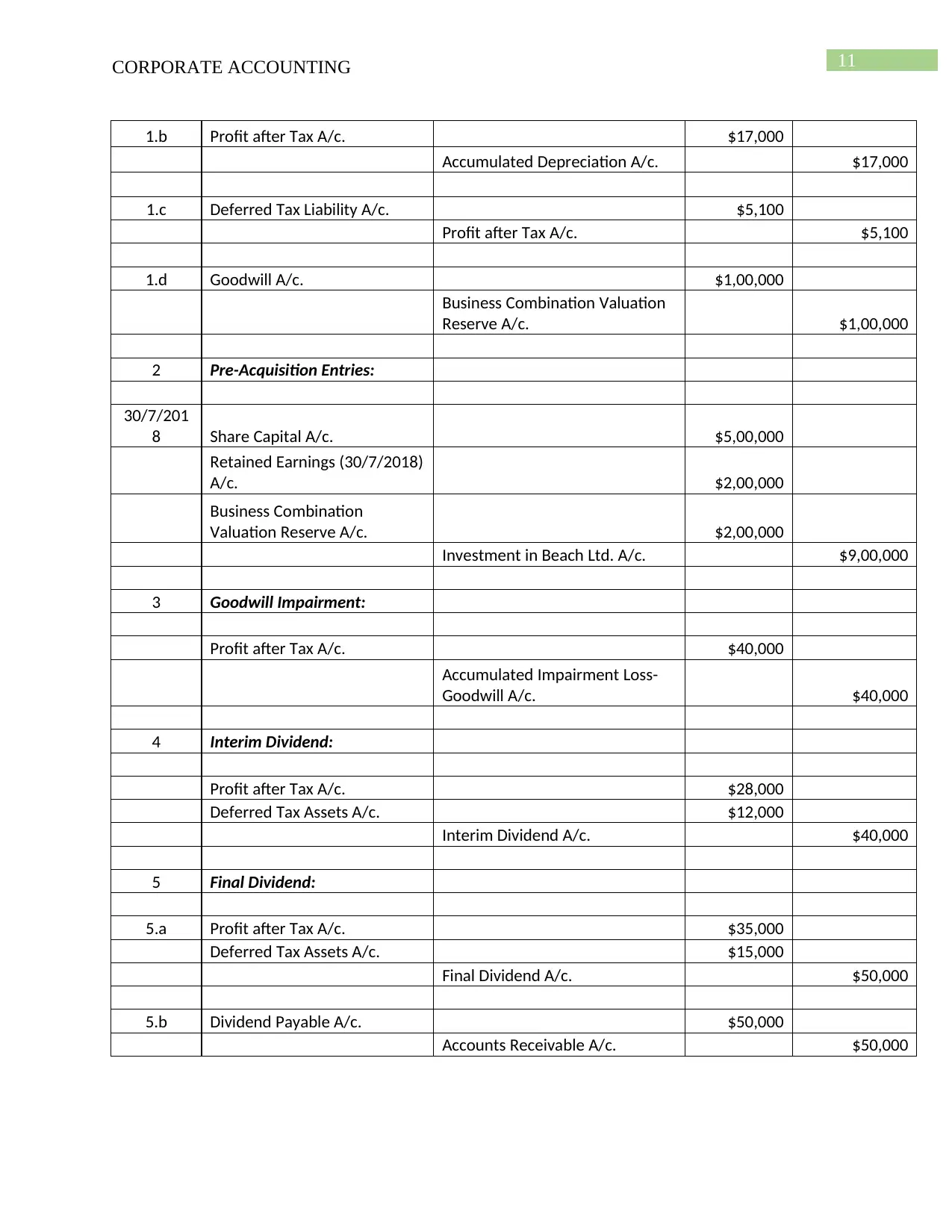
11CORPORATE ACCOUNTING
1.b Profit after Tax A/c. $17,000
Accumulated Depreciation A/c. $17,000
1.c Deferred Tax Liability A/c. $5,100
Profit after Tax A/c. $5,100
1.d Goodwill A/c. $1,00,000
Business Combination Valuation
Reserve A/c. $1,00,000
2 Pre-Acquisition Entries:
30/7/201
8 Share Capital A/c. $5,00,000
Retained Earnings (30/7/2018)
A/c. $2,00,000
Business Combination
Valuation Reserve A/c. $2,00,000
Investment in Beach Ltd. A/c. $9,00,000
3 Goodwill Impairment:
Profit after Tax A/c. $40,000
Accumulated Impairment Loss-
Goodwill A/c. $40,000
4 Interim Dividend:
Profit after Tax A/c. $28,000
Deferred Tax Assets A/c. $12,000
Interim Dividend A/c. $40,000
5 Final Dividend:
5.a Profit after Tax A/c. $35,000
Deferred Tax Assets A/c. $15,000
Final Dividend A/c. $50,000
5.b Dividend Payable A/c. $50,000
Accounts Receivable A/c. $50,000
1.b Profit after Tax A/c. $17,000
Accumulated Depreciation A/c. $17,000
1.c Deferred Tax Liability A/c. $5,100
Profit after Tax A/c. $5,100
1.d Goodwill A/c. $1,00,000
Business Combination Valuation
Reserve A/c. $1,00,000
2 Pre-Acquisition Entries:
30/7/201
8 Share Capital A/c. $5,00,000
Retained Earnings (30/7/2018)
A/c. $2,00,000
Business Combination
Valuation Reserve A/c. $2,00,000
Investment in Beach Ltd. A/c. $9,00,000
3 Goodwill Impairment:
Profit after Tax A/c. $40,000
Accumulated Impairment Loss-
Goodwill A/c. $40,000
4 Interim Dividend:
Profit after Tax A/c. $28,000
Deferred Tax Assets A/c. $12,000
Interim Dividend A/c. $40,000
5 Final Dividend:
5.a Profit after Tax A/c. $35,000
Deferred Tax Assets A/c. $15,000
Final Dividend A/c. $50,000
5.b Dividend Payable A/c. $50,000
Accounts Receivable A/c. $50,000
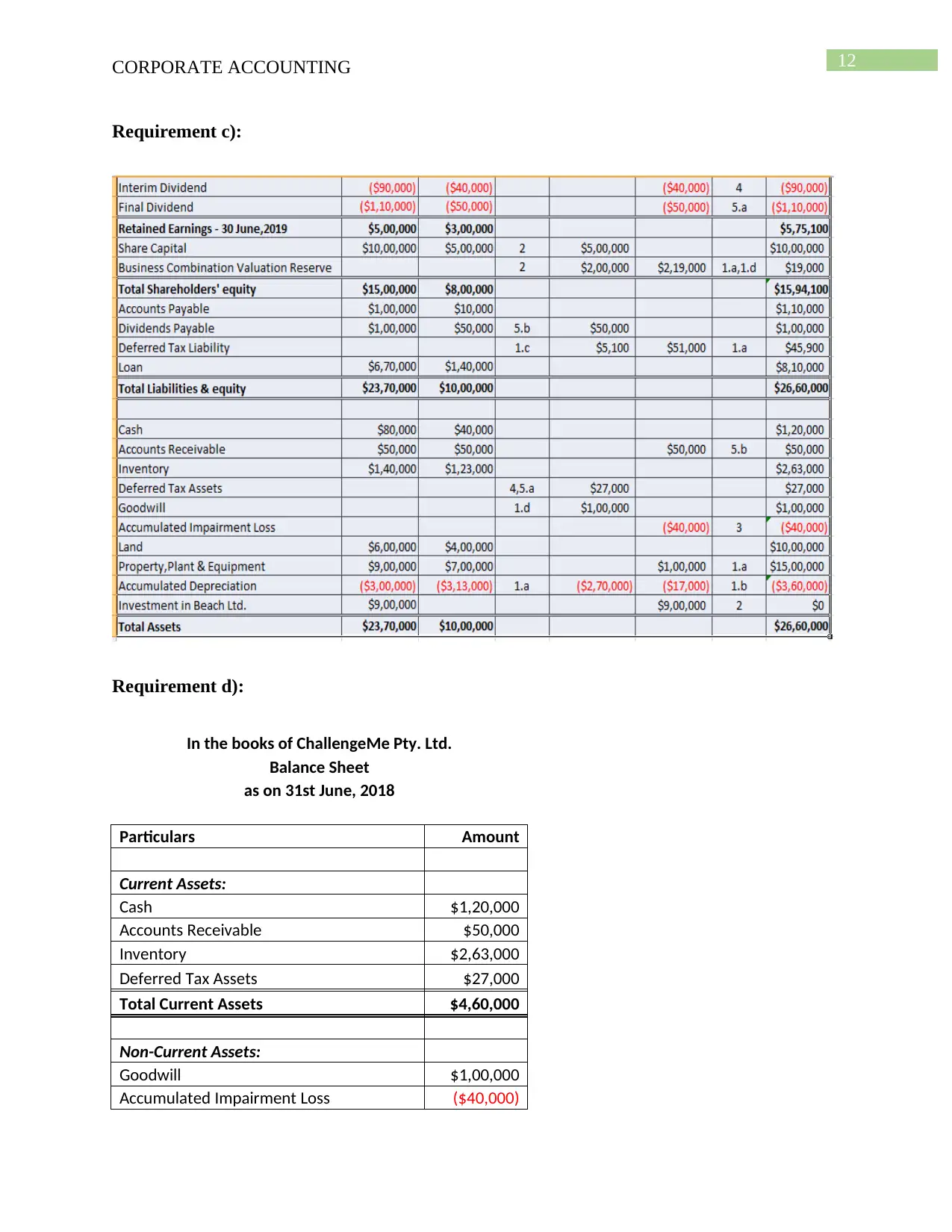
12CORPORATE ACCOUNTING
Requirement c):
Requirement d):
In the books of ChallengeMe Pty. Ltd.
Balance Sheet
as on 31st June, 2018
Particulars Amount
Current Assets:
Cash $1,20,000
Accounts Receivable $50,000
Inventory $2,63,000
Deferred Tax Assets $27,000
Total Current Assets $4,60,000
Non-Current Assets:
Goodwill $1,00,000
Accumulated Impairment Loss ($40,000)
Requirement c):
Requirement d):
In the books of ChallengeMe Pty. Ltd.
Balance Sheet
as on 31st June, 2018
Particulars Amount
Current Assets:
Cash $1,20,000
Accounts Receivable $50,000
Inventory $2,63,000
Deferred Tax Assets $27,000
Total Current Assets $4,60,000
Non-Current Assets:
Goodwill $1,00,000
Accumulated Impairment Loss ($40,000)
Paraphrase This Document
Need a fresh take? Get an instant paraphrase of this document with our AI Paraphraser
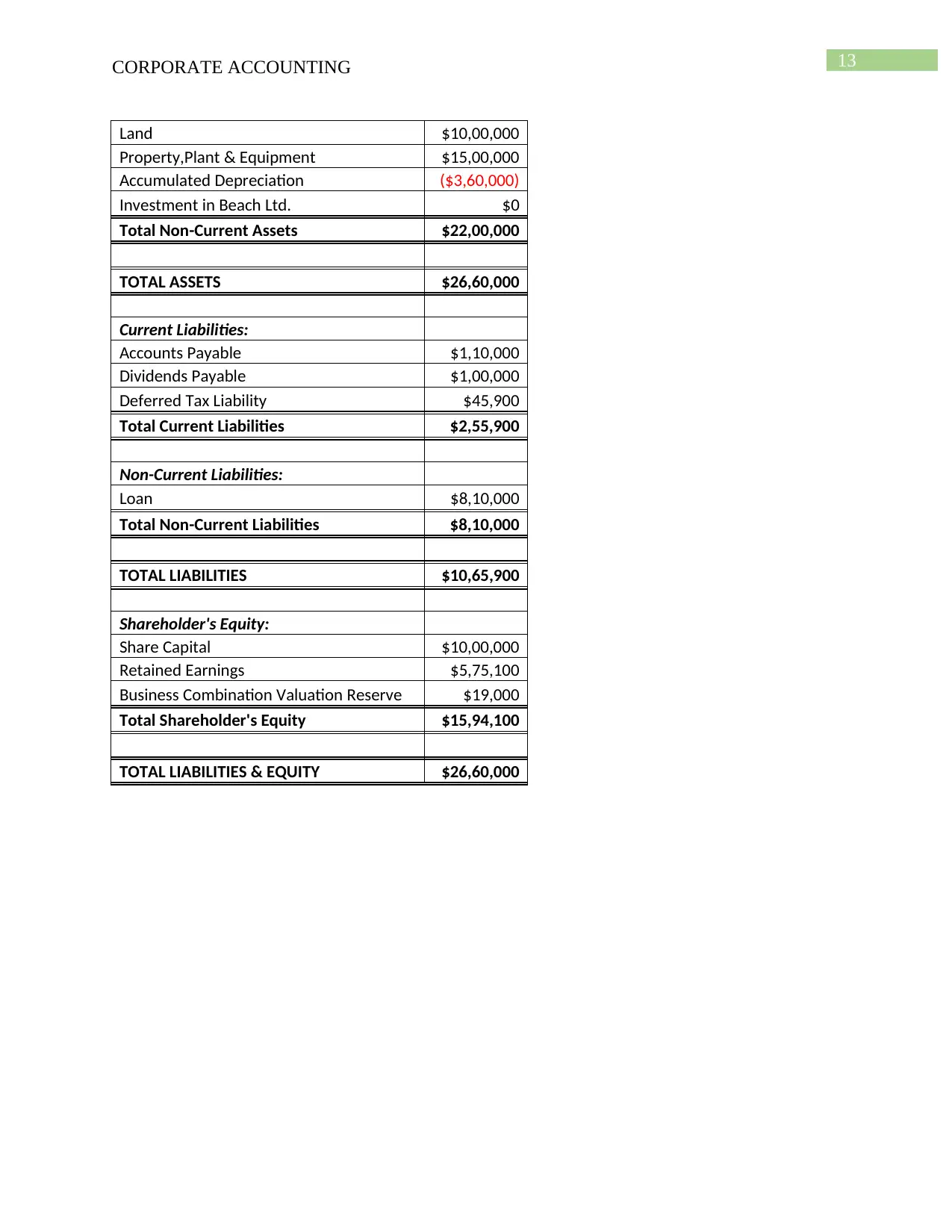
13CORPORATE ACCOUNTING
Land $10,00,000
Property,Plant & Equipment $15,00,000
Accumulated Depreciation ($3,60,000)
Investment in Beach Ltd. $0
Total Non-Current Assets $22,00,000
TOTAL ASSETS $26,60,000
Current Liabilities:
Accounts Payable $1,10,000
Dividends Payable $1,00,000
Deferred Tax Liability $45,900
Total Current Liabilities $2,55,900
Non-Current Liabilities:
Loan $8,10,000
Total Non-Current Liabilities $8,10,000
TOTAL LIABILITIES $10,65,900
Shareholder's Equity:
Share Capital $10,00,000
Retained Earnings $5,75,100
Business Combination Valuation Reserve $19,000
Total Shareholder's Equity $15,94,100
TOTAL LIABILITIES & EQUITY $26,60,000
Land $10,00,000
Property,Plant & Equipment $15,00,000
Accumulated Depreciation ($3,60,000)
Investment in Beach Ltd. $0
Total Non-Current Assets $22,00,000
TOTAL ASSETS $26,60,000
Current Liabilities:
Accounts Payable $1,10,000
Dividends Payable $1,00,000
Deferred Tax Liability $45,900
Total Current Liabilities $2,55,900
Non-Current Liabilities:
Loan $8,10,000
Total Non-Current Liabilities $8,10,000
TOTAL LIABILITIES $10,65,900
Shareholder's Equity:
Share Capital $10,00,000
Retained Earnings $5,75,100
Business Combination Valuation Reserve $19,000
Total Shareholder's Equity $15,94,100
TOTAL LIABILITIES & EQUITY $26,60,000
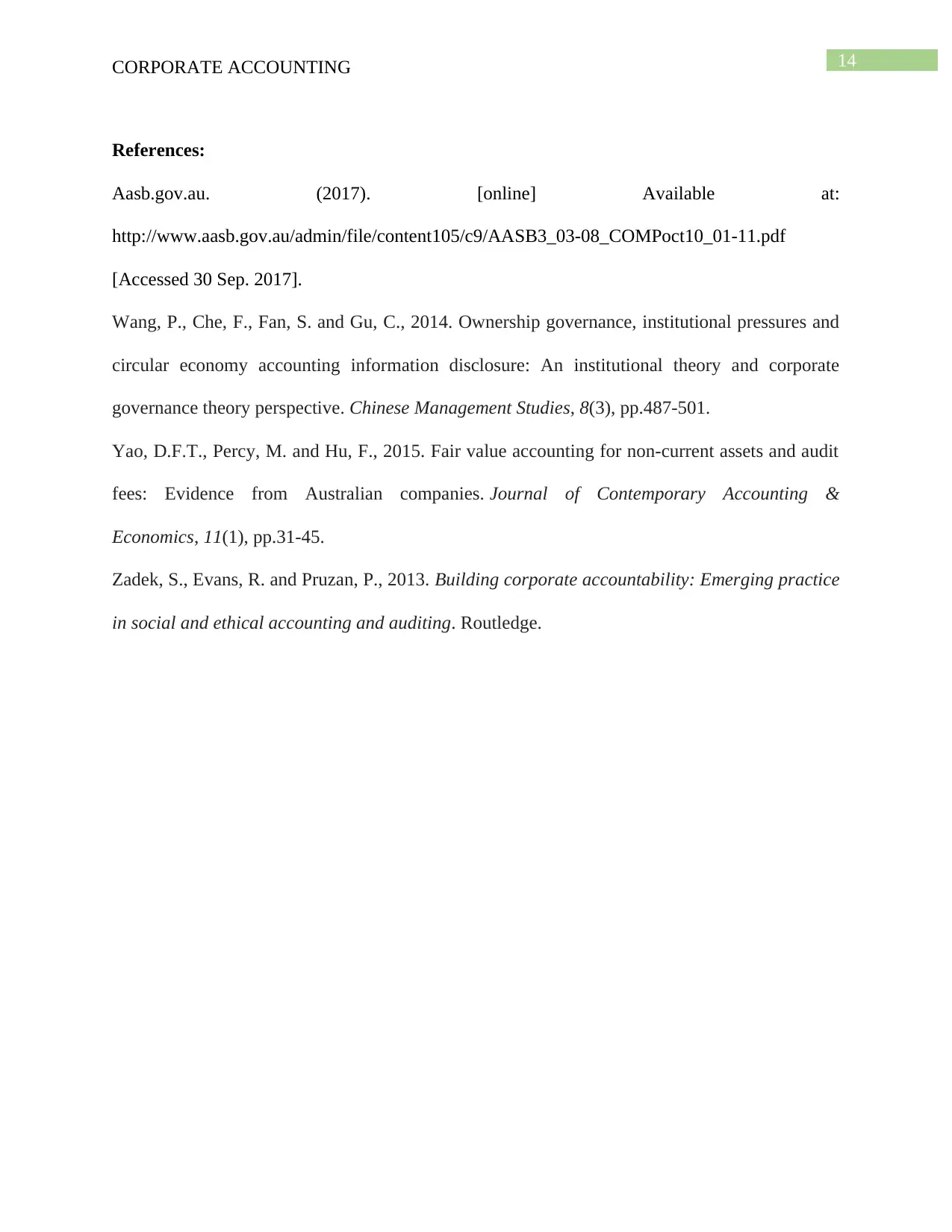
14CORPORATE ACCOUNTING
References:
Aasb.gov.au. (2017). [online] Available at:
http://www.aasb.gov.au/admin/file/content105/c9/AASB3_03-08_COMPoct10_01-11.pdf
[Accessed 30 Sep. 2017].
Wang, P., Che, F., Fan, S. and Gu, C., 2014. Ownership governance, institutional pressures and
circular economy accounting information disclosure: An institutional theory and corporate
governance theory perspective. Chinese Management Studies, 8(3), pp.487-501.
Yao, D.F.T., Percy, M. and Hu, F., 2015. Fair value accounting for non-current assets and audit
fees: Evidence from Australian companies. Journal of Contemporary Accounting &
Economics, 11(1), pp.31-45.
Zadek, S., Evans, R. and Pruzan, P., 2013. Building corporate accountability: Emerging practice
in social and ethical accounting and auditing. Routledge.
References:
Aasb.gov.au. (2017). [online] Available at:
http://www.aasb.gov.au/admin/file/content105/c9/AASB3_03-08_COMPoct10_01-11.pdf
[Accessed 30 Sep. 2017].
Wang, P., Che, F., Fan, S. and Gu, C., 2014. Ownership governance, institutional pressures and
circular economy accounting information disclosure: An institutional theory and corporate
governance theory perspective. Chinese Management Studies, 8(3), pp.487-501.
Yao, D.F.T., Percy, M. and Hu, F., 2015. Fair value accounting for non-current assets and audit
fees: Evidence from Australian companies. Journal of Contemporary Accounting &
Economics, 11(1), pp.31-45.
Zadek, S., Evans, R. and Pruzan, P., 2013. Building corporate accountability: Emerging practice
in social and ethical accounting and auditing. Routledge.
1 out of 15
Related Documents
Your All-in-One AI-Powered Toolkit for Academic Success.
+13062052269
info@desklib.com
Available 24*7 on WhatsApp / Email
![[object Object]](/_next/static/media/star-bottom.7253800d.svg)
Unlock your academic potential
© 2024 | Zucol Services PVT LTD | All rights reserved.




